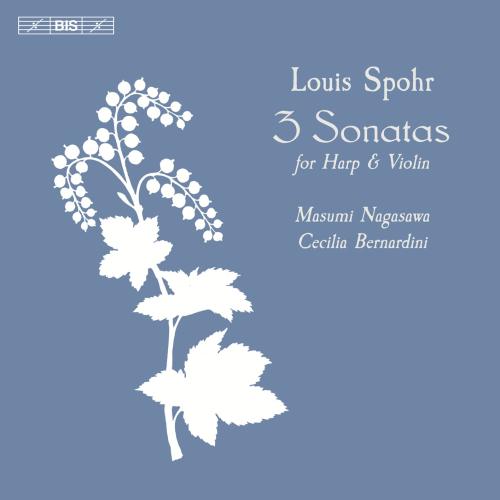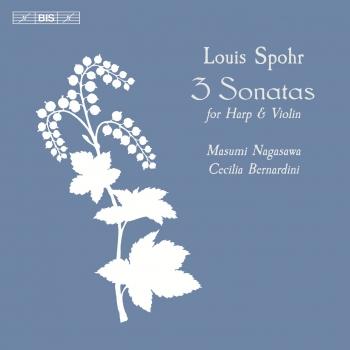
Spohr: Sonatas for Harp & Violin Cecilia Bernardini & Masumi Nagasawa
Album info
Album-Release:
2018
HRA-Release:
01.06.2018
Album including Album cover Booklet (PDF)
- Louis Spohr (1784-1859): Sonata for Violin & Harp, Op. 113:
- 1 I. Allegro brillante 10:40
- 2 II. Adagio 04:04
- 3 III. Rondo allegretto 07:14
- Sonata for Violin & Harp, Op. 115:
- 4 I. Allegro 13:05
- 5 II Larghetto 04:54
- 6 III. Rondo 10:33
- Sonata for Violin & Harp, Op. 114:
- 7 I. Allegro - Vivace 12:07
- 8 II. Andante. Potpourri on Themes from The Magic Flute 10:37
Info for Spohr: Sonatas for Harp & Violin
In 1805, on the basis of his brilliant yet expressive playing, the 21-year-old Louis Spohr was appointed Konzertmeister at the ducal court in Gotha. By this time he had also begun to make his mark as a composer, and during his years at the court he would add several pieces for the harp to his list of works, inspired by the young harpist Dorette Scheidler. Spohr later recalled his reaction to her playing: ‘I was so deeply moved that I could scarce restrain my tears... I took my leave – but my heart remained behind!’ Only months later, the two were in fact married and Spohr began to compose works which would form the repertoire during future concert tours. Dorette Spohr played a so-called single-action pedal harp of a similar type to the instrument used on this disc. Soon to be replaced by the double-action pedal system, the single-action pedal harp was best suited for playing in flat keys. As Spohr preferred writing his violin parts in sharp keys, which allowed the resonance of the open strings, he adopted the method of tuning the harp a semitone lower, which had the added benefit of reducing the tension on the strings. The Sonatas Opp 113-115, in D and G major, therefore have harp parts notated in E flat and A flat major respectively. Because of its delicate construction and stringing, the single-action harp has a distinct silvery bell-like sound and these sonatas are among the last important works specifically written for it. They are also the most demanding, but it is clear that Spohr intended them to display not only the technical skill of the two artists but also their musical expressiveness. The performers here are Masumi Nagasawa and Cecilia Bernardini, who have made a particular study of Spohr's writings on performance practice.
Masumi Nagasawa, single-action pedal harp
Cecilia Bernardini, violin
Cecilia Bernardini
is widely considered to be one of the most versatile violinists of her generation, performing on both the modern and the baroque violin.
She obtained prices in major violin competitions amongst which Oskar Back Vioolconcours, Concorso Internazionale Violinistico Andrea Postacchini and Leopold Mozart Competition Augsburg.
As a soloist, Cecilia has performed in many of Europe's most prestigious concert halls, including the Concertgebouw Amsterdam, Musikverein Vienna and Konzerthaus Berlin, playing much of the main violin concerto repertoire, including the Bach violin concertos and double concertos, several Mozart concertos, Beethoven, Brahms, Bruch and Szymanowski. In 2010, she performed the violin solo part at the world première of Philip Glass's Double Concerto for Violin, Cello and Orchestra with the Residentie Orkest.
Cecilia frequently leads and directs modern and period instrument ensembles including Ensemble Zefiro, Arcangelo with Jonathan Cohen (recordings with Hyperion), Pygmalion with Raphael Pichon (recordings with Erato), Tafelmusik Baroque Orchestra in Toronto, Holland Baroque Society, The King’s Consort (performing and recording with them widely across Europe in repertoire as diverse as Purcell, Handel, Bach, Haydn, Stanford and Britten), Scottish Chamber Orchestra with Robin Ticciati (including the Edinburgh International Festival), Camerata Salzburg (including the Linz Brucknerhaus and the Salzburg Festival), Bach Collegium Japan, Swedish Radio Symphony Orchestra and The Netherlands Bachvereniging with Jos van Veldhoven.
With her great passion for chamber music, Cecilia is a member of the Serafino String Trio, joining violist Giles Francis and cellist Timora Rosler. She has a duo with fortepianist Keiko Shichijo (with whom she did an extensive tour at the Utrecht Oude Muziek Festival) and regularly performs with her father, baroque oboist Alfredo Bernardini. Past Chamber music partners include baroque violinist Stanley Ritchie, double-bass player Rick Stotijn, fortepianist Kristian Bezuidenhout, pianist Alexandre Tharaud and cellist Colin Carr.
In 2012 Cecilia was appointed leader of the Dunedin Consort, based in Scotland, with whom she has recorded Bach's St. John Passion and a best-selling disc of the Brandenburg Concertos, which has been nominated for a Gramophone award at the same time as Mozart’s Requiem by the same group. Future releases with the Dunedin Consort include Bach's Violin Concertos and Bach's Christmas Oratorio and Magnificat.
Future engagements include several appearances at the Wigmore Hall in London, both as an orchestral leader and as a soloist (Bach violin concertos with Dunedin Consort), performances at the Bruges Early Music Festival (Biber's Rosary sonatas with Richard Egarr), Thüringer Bachwochen (Brandenburg Concertos with Holland Baroque Society), Sablé Early Music Festival and several recordings including Purcell's sonnatas in three parts with the King's Consort.
Masumi Nagasawa
is one of the few harpists to perform on the modern Grand Harp, the single-action pedal harp (18th-19th century historical harp), the Irish harp and the kugo or Japanese ancient harp. She studied modern harp with Phia Berghout at the Conservatory in Maastricht and historical harp with Mara Galassi. She gained her solo diploma cum laude as well as the award of the Prix d’Excellence. She received the Muramatsu Music Prize Grand Prix Japan in 1990, awarded only to prestigious musicians. She has since been invited to International Festivals and also to various International Harp competitions as a jury member, these including the Concours de harpe Lily Laskine in Paris. Numerous of her CDs are released by Toshiba EMI Japan, Etcetera and Channel Classics.
Masumi has given recitals in major concert halls in Amsterdam, Tokyo, Budapest, Rome, Prague, Washington D.C., Copenhagen and Brussels. Her recitals are highly varied, always changing with the development and expansion of her repertoire. She has been a soloist with the Amsterdam Concertgebouw Chamber Orchestra, St. John’s College Choir Cambridge and has also appeared as a soloist together with Dame Kiri Te Kanawa and Cecilia Bartoli. International festivals where she has been invited to perform include the Kuhmo International Chamber Music Festival, the Salzburg Music Festival, the Geneva Music Festival, the Akiyoshidai International Music Festival, the Ittinger Pfingstkonzerte, and the Torino Milano Festival Internazionale della Musica.
On historical harp she has performed with the Academy of Ancient Music, the Freiburger Baroque Orchestra, the Balthasar-Neuman Ensemble, the Kammerorchester Basel, the Orchestra La Scintilla and the Netherlands Bach Society.
Alongside her concert appearances she both composes and arranges music for the harp; this has also been published and recorded.
She currently teaches at the Conservatory in Maastricht. She is also completing her PhD at Leeds University in England under Professor Clive Brown on “ Single-action pedal harp and their implications for the performing practice of its repertoire from 1760 to 1830”.
Booklet for Spohr: Sonatas for Harp & Violin





